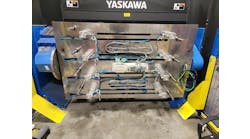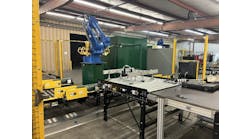Robot applications and implementations continue to become simpler, despite the explosion of robotic growth and manufacturing. The robot-manufacturer market consists of more than 500 companies, which make conventional industrial robots and cobots; automated guided vehicles (AGVs) for transporting large and small loads in logistics or assembly lines; stationary medical and agricultural applications; and mobile cleaning, construction and underwater activities, according to Boston Consulting Group’s “Robotics Outlook 2030: How Intelligence and Mobility Will Shape the Future,” released in 2021.
More than half a million robots were installed that same year, according to the International Federation of Robotics’ (IFR) World Robotics Report 2022. The bulk of those came from a handful of companies, including ABB, Fanuc, Yaskawa, Kuka, Mitsubishi, Kawasaki, Nachi, Denso, Epson, Stäubli, Comau, Omron, Universal Robots and Foxconn.
Programming and controlling multiple brands and types of robots can be daunting, especially when they need to be integrated into an existing control architecture whose programmers might only be familiar with IEC 61131-3 languages.
Ready Robotics’ ForgeOS platform is designed to enable operators to control and program multiple brands of robots from a single user-friendly interface with minimal training. Using Task Canvas, one of many ForgeOS Productivity apps included with the platform, operators can create new automation tasks with a no-code, flowchart-based interface.
Rockwell Automation’s strategic investment in Ready Robotics, a Rockwell Technology Partner, marks a significant step in the integration path.
“The collaboration between Rockwell and Ready Robotics enables an unprecedented degree of simplification in the application of robots,” said Matheus Bulho, vice president and general manager, production automation, at Rockwell. “It not only reduces the need for programming with a low-code approach to the creation of the robot application but also allows system integrators and machine builders to improve productivity with a common approach to programming and management of robot systems from multiple vendors.”
Historically, automation has been hampered by software silos between robot vendors, explained Ben Gibbs, CEO and co-founder of Ready Robotics. “Ready’s interface alleviates this issue, eases deployment and enables automation where it might have been prohibitive before, especially in high-mix operations,” he said. “Our platform enables programming and control of over 3 million compatible robots deployed today."
Rockwell and Ready Robotics have collaborated to integrate ForgeOS with Rockwell’s line of Logix controllers and design and simulation software. The combination will simplify robot integration and accelerate time to market of industrial-automation deployments. Rockwell’s investment is designed to foster continued development of the ForgeOS platform, support its integration with Logix and accelerate adoption across the Rockwell ecosystem of system integrators and technology and channel partners.
“We are excited to work with Ready Robotics to help further simplify the use of diverse robotic systems in automation solutions for our customers,” continued Bulho. “Linking the intuitive ForgeOS software suite with Logix control, design and emulation capabilities allows a broader range of businesses to implement these powerful tools and spend less time getting their systems up and running.”





